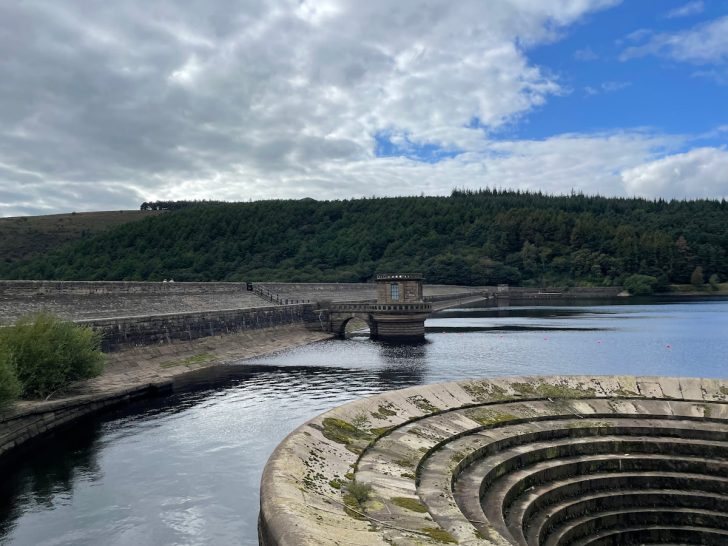Nestled in the heart of Derbyshire, the Ladybower Reservoir serves as a cornerstone of the Peak District’s natural attractions and provides a vital supply of drinking water to the surrounding area.
Known for its scenic beauty and recreational opportunities, the reservoir is famed for its distinctive “plughole” spillways, which offer visitors a unique spectacle.
This article will delve into the reservoir’s history, design, and location of the plugholes.
The Plughole Phenomenon
The plugholes of Ladybower are engineering marvels. Each plughole is 24 meters in diameter with a dramatic drop of 20 meters, designed to channel overflow water through tunnels leading to the River Derwent.
These bellmouth spillways become particularly captivating during high water levels, usually in the wetter months of winter and spring, when they create a vortex as water spirals dramatically into their depths.
You can view an equally impressive water feature at Derwent Dam, an equivalent man-made waterfall in the Peak District, where the water flows over the dam wall.
Ladybower Plughole Walking Routes & Viewing Points
Ladybower Reservoir is encircled by a variety of walking trails that cater to all levels of hikers:
- Short Walks under 1.6 km (1 mile): Ideal for families with children or those seeking a gentle stroll around the reservoir. These walks offer stunning views of the plugholes.
- Start at Heatherdene car park and follow the path past the toilets. This will lead you down to a road, which you need to cross to reach the dam wall and the plugholes.
- Long Walk around 6.5 km (4 miles): This route allows for more extensive exploration around the reservoir, such as reaching the peak of Win Hill or the top of Bamford Edge, suitable for hikers looking for moderate treks.
- Also, park at Heatherdene car park and take the path out past the toilets, which will lead you down to the road. Cross this to continue over the dam wall towards Win Hill, or turn left to reach the top of Bamford Edge.
Visitor Information
Visitors to Ladybower Reservoir have access to convenient parking options near the Yorkshire Bridge Inn or the Heatherdene car park. These areas are equipped with facilities such as toilets, a boot wash station, picnic benches, and typically an ice cream van on a sunny day.
The area is well-suited for visitors of all ages, including accessible paths for those with children or limited mobility. The best times to visit for photography enthusiasts are early morning or late afternoon, particularly in winter when the light is most favourable for capturing the dramatic interplay of light and water at the plugholes.
Historical Background
Constructed between 1935 and 1943, Ladybower Reservoir was primarily built to supply water to the East Midlands.
Beyond its utilitarian purposes, the reservoir has historical significance tied to World War II, serving the country during critical times.
The reservoir features two bellmouth spillways, commonly referred to as “plugholes,” which are designed to prevent flooding by draining excess water. These architectural feats are not only functional but have also become a focal point of local lore and attraction.
Environmental and Conservation Aspects
The Ladybower Reservoir plays a crucial role in the local ecosystem. It supports various wildlife and plant species, enhancing the biodiversity of the region.
Conservation efforts are continuously made to preserve the natural beauty and ecological balance of the area. The reservoir not only serves as a habitat but also as a site for environmental education and awareness, encouraging visitors to engage with and respect the natural world around them.
By combining historical significance with natural beauty and recreational opportunities, the Ladybower Reservoir and its renowned plugholes remain a cherished destination, inviting explorers to discover its depths and delights.



SamanthaP
Tuesday 2nd of July 2024
Whilst it's evident the Ladybower Reservoir offers picturesque views and recreational opportunities, it's integral to discuss the implications such bodies of water have on local ecosystems. The balance between human activity and conservation efforts must always be considered to ensure the preservation of biodiversity in these areas. I'd be keen to learn more about the specific measures in place at Ladybower for this.
Mick_G
Thursday 4th of July 2024
does anyone do clean ups there? wanna help out if poss.
Dave X
Tuesday 25th of June 2024
Seems like a lot of fuss over a bit of water. bet there’s places with better views and less people crowding.
Kirsty Smith
Thursday 13th of June 2024
The historical significance of Ladybower Reservoir is truly fascinating. It's not just a place for leisure but a piece of engineering marvel that played a vital role during its time. The environmental impact it has had over the years also sheds light on the importance of maintaining such landmarks for future generations.
J-dawg
Thursday 6th of June 2024
If you listen close, the plughole whispers your secrets. Or was that just the voices in my head again?
Lisa-Marie
Thursday 23rd of May 2024
I'm planning a visit to Ladybower Reservoir and was wondering about the best time of year to see the plughole in action. Could anyone please advise?
Gary F
Thursday 13th of June 2024
Spring is great, saw it last April!